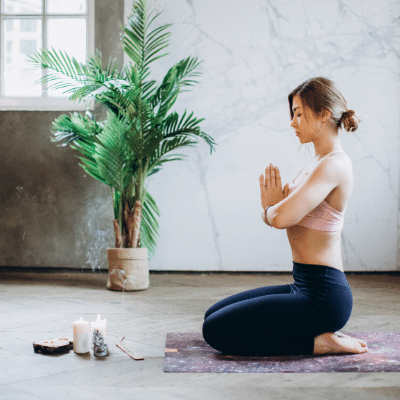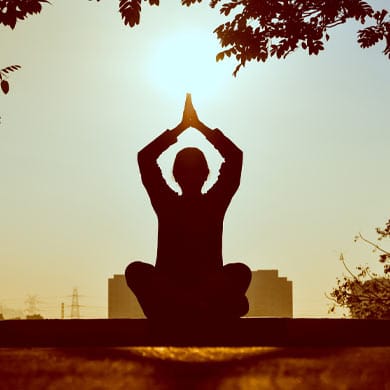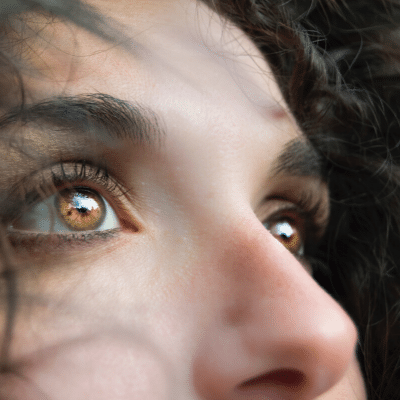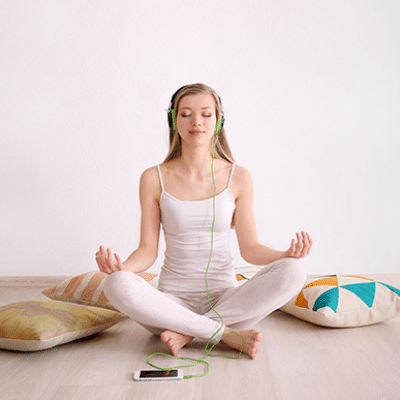

There are remarkable benefits available when you learn how to meditate, especially for those already using The Law Of Attraction. Helping you to become more in tune with your own thoughts to improve your overall well-being, meditation has something to offer everyone.
If you are a complete meditation beginner, you may be wondering how to get started. Learning to how to meditate isn’t as complex as you might think. If you want to experience the positives that the practice can bring, then here is a beginner’s guide to meditation.
Although meditation is enormously popular, you may not have heard much about its origins. The word has its roots in the Latin term “meditatum”, which translates to “ponder.” But who first suggested the practice, and how did it evolve?
There is some compelling evidence suggesting the hunter-gatherer culture involved meditation, the earliest proper records that we have of meditative practices indicates that the history of meditation truly begins around 1500 BCE. In its earliest incarnations, it appears to have been part of early Hindu tradition in India. Over a thousand years later, it was also seen as part of Buddhist practices in India and Chinese Taoism. Meanwhile, interest in meditation was later cultivated in Western society first by Philo of Alexandria and later by Saint Augustine.
To fully grasp the history of meditation, it's important to note the split that appeared in the Eastern traditions of Hindu and Buddhist meditation respectively. While Hindus believed that meditation could be used to essentially commune with God, the Buddhist perspective held that we could use the practice to better understand the interconnectedness between all things. It is this non-religious reading of meditation that is most commonly adhered to today, with people of all spiritual backgrounds considering it a plausible way to improve mental health, coping with stress and induce feelings of calmness.
The modern perspective on meditation can be traced back to the 1960s and 1970s, when medics and psychologists began to abandon the stigma associated with religious meditation and started to investigate the possible benefits in a healthcare setting (partly in conjunction with the development of hypnotherapy practices). As research continued, scientists found proof the meditation could reduce the physical signs and symptoms of stress.
Now, there are dozens of different types of meditation, ranging from breathing exercises to mindfulness body scanning, creative visualization, and loving-kindness meditations. This article will help you to understand how to meditate, the benefits as well as some very useful tips you can apply along the way.
As you probably know, the health benefits of meditation are incredibly wide-ranging. Once viewed as merely a way to gain calmness or perspective, it is now a suggested part of a whole host of different treatment programs.
A regular meditation practice can impact on both mental and physical health, and it can also take advantage of the most important links between the two.
We'll explore the major positive effects of meditation below, with reference to some of the most exciting new research that proves how meditation impacts on the body and mind.
Scientists are constantly studying the physical benefits of meditation, but some of the most well-established include the following:
Since it seems that meditation first originated as a religious practice, it is unsurprising that it offers spiritual benefits. Even if you are agnostic or consider yourself an atheist, you can still have a fulfilling spiritual life. Some of the benefits of meditation in this respect include:
Meditation has recently received a lot of attention. It can be used as a tool for coping with mental health issues and improving your emotional well-being. This is with good reason–the mental health benefits of daily meditation include the following:
The benefits of meditation are fairly consistent, regardless of which type you practice. However, some personalities are better suited to some types than others, and some forms of meditation do place a particular emphasis on certain benefits. Your main choices include these forms of meditation.

Movement meditation is any type of meditative practice that involves physical movement.
No matter the kind of movement involved, movement meditation is all about tuning into your body.
It challenges you to be fully physically present.
By turning your full attention to the body in this way, you calm and slow your thoughts.
Yoga Meditation is an excellent example of movement meditation.
There are several types, including Qigong Meditation and Kundalini Yoga.
You can benefit from using your breath to control the pace in any yoga meditation.
Inhale as you move your body into the new pose, and exhale as you fully settle into the stretch.
As you keep your breathing slow and steady, you'll find your thinking becomes slower and clearer as well.
Yoga is the primary form of movement meditation.
However, any bodily movement can be turned into a meditative exercise if you challenge yourself to fully inhabit that movement.
For example, to turn a daily walk into a form of movement meditation, simply slow your pace and turn your full attention to how your body feels as you walk – to the way your muscles relax and contract, and how the air feels on your skin.

Mindfulness meditation is a broader category than movement meditation, but it shares many of the same goals.
Specifically, mindfulness is about committing your full attention to whatever you're doing in the present moment.
This can be a simple daily activity, like cooking, or it might take the form of a specific mindfulness exercise.
For example, practicing how to meditate with a body scan involves focusing your attention on each part of the body in turn.
Starting with your head and working your way to your toes, notice how each part feels.
Where are you holding tension? Which parts of your body feel loose and relaxed?
Try not to make any judgments, focusing simply on observing.
Mindfulness is sometimes called Zen Meditation, as the practice has its roots in Buddhist traditions and it aims to calm and simplify your thinking.
In time, practicing mindfulness actually changes how you think in your daily life.
In particular, it helps you live in the present and encourages you to be deeply aware of your own thoughts and feelings without being overwhelmed by them.
Research shows that mindfulness actually changes your brain, improving emotional regulation.

The goal of spiritual meditation is to connect you with something greater than yourself.
For some people, this will be intimately linked to religious beliefs.
For others, spiritual meditation is more about reminding yourself that you are connected to every other living thing in the universe, and about reflecting on your life's purpose.
There are many different strands of meditation that are particularly good for spiritual development.
For example, Transcendental Meditation is a silent, mantra-focused practice.
You practice for up to 20 minutes per day, focusing on a sound or a phrase that you repeat in your head.
All forms of mantra meditation aim to keep your head free of restless thoughts by keeping your awareness tied to a simple, repetitive word, sound, or sentence.
Other examples of spiritual meditation include Vipassana Meditation and Chakra Meditation.
Both aim to help you enhance your spiritual side and increase your awareness of the wider universe.
Chakra meditation is based on the belief that focusing on different energy centers can help to treat particular mental, physical and emotional blocks.
Meanwhile, Vipassana meditation is an ancient Indian spiritual practice that revolves around deepening the connection between mind and body.

Visualization meditation uses your imagination to its full potential, requiring you to build vivid mental images that represent particular meditation goals.
In the simplest terms, you picture something before it has already happened.
For example, you may already be aware of the creative visualization techniques involved in the Law of Attraction meditation.
This involves sitting with your eyes closed for 10-15 minutes, imagining how it will feel to have the thing you desire – whether it's love, your dream job, financial abundance, or something else.
Athletes often use a similar type of technique.
For example, a golfer might visualize themselves hitting a hole in one, or a soccer player might see herself scoring the winning goal.
Loving Kindness Meditation is another type of visualization meditation.
You might picture yourself emitting bright, warm energy that makes its way to someone you love.
You may find it helpful to expand this exercise, imagining yourself sending the same energy to someone you have mixed feelings toward, and even to someone you find challenging.
Here, the aim is to develop compassion for all beings and to make love your default stance.

Guided meditation is any form of meditation where someone guides you through what you are meant to visualize and focus on.
This can be someone in person, or (more commonly) a recording.
Hypnosis meditation is one of the most popular types of guided meditation.
A hypnotherapy practitioner leads you into a deeply relaxed state and then helps you to rewrite limiting beliefs.
They might guide you toward new reactions to a phobia or assist you in working on your anxiety.
Sound Bath Meditation involves listening to ambient sounds.
Sometimes this is gentle music, and other times it is sound from nature – the ocean, wind, rain, or whale song.
At some point during the recording, a voice will guide your thoughts and focus.
Meanwhile, certain loving-kindness meditations can also be guided meditations.
In fact, all of the above forms of meditation can be turned into guided meditations if someone narrates your meditative journey.
A major benefit of guided mediation is that someone else assists with your focus.
They keep you on track, gently return your attention to the present moment, and can help you concentrate (when you may otherwise accidentally become distracted).
To set yourself up for success, create your own personal meditation area in which to practice.
Background noise, such as the television and radio, will cause distraction and disrupt your train of thought. Instead consider peaceful, tranquil, and meditation-friendly audio and music.
It’s also best to choose a fairly cool or warm area to meditate. Being too cold or too hot won’t allow you to concentrate.
Make sure you’re in a suitable area where you won’t be disturbed.
To meditate, you’ll need to find a comfortable position in which to sit for ten to fifteen minutes. You don’t need to adopt a specific position if you are going to find it hard to adapt.
Generally, the regular position for meditation is with crossed legs and hands on your lap. However, if you struggle with this at first, find a position you are comfortable with. Just ensure that you are not slouching.
Understand how to meditate with a focused breathing rhythem is an important process. However, you want it to be natural.
Start by closing your eyes and take a few deep breaths. Let it begin with shallow breaths, and just continue to breathe for a few minutes.
Your intake of breath will become deeper as you progress. Take your time to breathe slowly as there is no need to force it.
Recommended reading: Deep Breathing Benefits & How To Breathe Properly

Through deep breathing, you should feel more at ease. Once that happens, turn your focus to the actual process of breathing.
Be conscious of each breath that you inhale and each that you exhale. It may take a while for your mind to fully focus on your breathing.
Don’t worry if you struggle with your train of thought. It’s perfectly ok for your mind to wander onto other subjects. Simply let it drift and gently try to bring your attention back to your breathing.
It may be difficult to concentrate, whether you’re a beginner at meditation or not, however, as you start to continually practice, your attention should gradually improve.
If you find it easier, then use numbers to ‘count’ your breathing. So, for instance, count one to inhale and two to exhale, and continue to repeat these numbers as you breathe in and out. This can be an effective way to get into the mindset when learning how to meditate.
When you are ready to end your meditation, open your eyes. You should be in a calm and serene state.
When you’re first learning how to meditate, it's important to view it as a skill that you cultivate and strengthen over time. When you’re just getting started, use these meditation tips to enhance your practice…
Okay, so where do you go from here?
You may wish to begin exploring meditation techniques like self-hypnosis, or you may be interested to try out music programs like ZenHarmonics – this is a next-generation meditation music that utilizes a very unique technology called MRT. You can try it out at no cost here.
